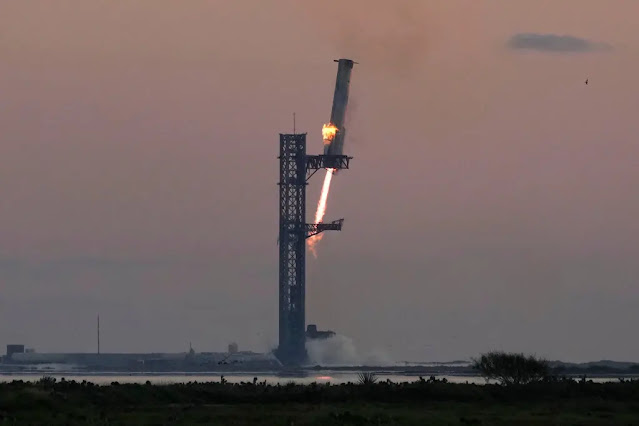SpaceX Achieves Mixed Results in Latest Starship Test Flight
SpaceX's newest Starship test flight Tuesday delivered a mix of setbacks and successes, highlighting both the progress and challenges in developing the world's most powerful rocket system. While the massive booster stage couldn't be recovered as planned, the upper stage successfully completed a groundbreaking maneuver before splashing down in the Indian Ocean.
The launch drew special attention as President-elect Donald Trump visited SpaceX's South Texas facility to show support for Elon Musk, who has become an increasingly important figure in Trump's transition team. Despite the high-profile political presence, SpaceX maintained its technical focus during the livestream, emphasizing the engineering aspects of the mission.
"Development testing, by definition, is unpredictable," explained Jessie Anderson, a SpaceX manufacturing engineering manager during the broadcast. "But that is exactly why we test."
## A Record-Breaking Vehicle
The Starship system stands as an engineering marvel, reaching 397 feet in height—towering 90 feet above the Statue of Liberty and its pedestal. Its Super Heavy booster, equipped with an unprecedented 33 Raptor engines, generates a staggering 16 million pounds of thrust at full power. The upper stage, dubbed Starship, features a distinctive stainless steel design reminiscent of 1950s science fiction, complete with prominent fins.
## Launch and Early Challenges
The launch commenced precisely at 4 p.m. Central time from the Starbase facility near Brownsville, carrying an unusual passenger: a plush banana in its cargo hold. The mission plan initially called for the Super Heavy booster to return to its launch tower—a feat previously accomplished in October using mechanical "chopsticks." However, this complex maneuver was abandoned mid-flight, resulting in the booster splashing down in the Gulf of Mexico instead.
## Upper Stage Success
Despite the booster recovery setback, the upper stage achieved several crucial objectives during its hour-long journey. In a significant milestone, engineers successfully reignited an engine in space—a critical capability for future orbital operations. NASA Administrator Bill Nelson praised this achievement on X, noting, "Starship's success is Artemis' success," referencing the $4.4 billion in NASA contracts awarded to SpaceX for lunar missions.
The flight concluded with a dramatic re-entry sequence, as the spacecraft executed a carefully controlled descent through Earth's atmosphere. Using its flaps for steering, Starship transitioned from a nosedive to a vertical orientation before making its planned splashdown in the Indian Ocean, drawing cheers from observers.
## Political Implications
The test flight's political context underscores growing ties between Musk and the incoming Trump administration. Trump recently announced Musk would lead a new government agency, and their strengthening alliance could impact SpaceX's regulatory environment. The company has previously expressed frustration with environmental reviews by the FAA and Fish and Wildlife Service, which they say have slowed Starship's development.
## Future Aspirations
Looking ahead, SpaceX maintains ambitious plans for Starship, including potential uncrewed Mars missions as early as 2026. The company is also exploring possibilities for high-speed point-to-point travel on Earth, potentially enabling half-hour journeys across the globe. While NASA currently plans to use a modified Starship as a lunar lander, the incoming administration might redirect focus toward Mars exploration, aligning with Musk's long-term vision of establishing human presence on the red planet.
The successful aspects of Tuesday's test, particularly the upper stage performance, mark important progress toward these goals, even as challenges remain in perfecting the full system's reusability.




